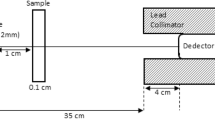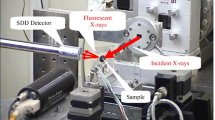Abstract
Particle induced X-ray emission technique was used to obtain the serum elemental profile of healthy subjects and breast cancer patients (BCPs) undergoing chemotherapy. Concentrations of elements K, Ca, Ti, V, Cr, Mn, Fe, Co, Cu, Zn, Se, Br, Rb, and Sr were determined. The increased levels of Ca, Cr, Fe and Cu and diminished levels of Ti, Zn, and Se observed in BCPs prior to therapy, were restored to near normal levels after the fifth cycle of chemotherapy. This work elicits a unique possibility of identifying novel trace element based anti-tumour drugs for breast cancer.





Similar content being viewed by others
References
Cancer Facts & Figures (2019) American Cancer Society, Atlanta
Silvera SAN, Rohan TE (2007) The trace elements and cancer risk: a review of the epidemiologic evidence. Cancer Causes Control 18:7–27
Maggini S, Wintergerst ES, Beveridge S, Hornig DH (2007) Selected vitamins and trace elements support immune function by strengthening epithelial barriers and cellular and humoral immune responses. Br J Nutr 98:S29–S35
Sarita P, Naga Raju GJ, Pradeep AS, Rautray TR, Seetharami Reddy B, Bhuloka Reddy S, Vijayan V (2012) Analysis of trace elements in blood sera of breast cancer patients by particle induced X-ray emission. J Radioanal Nucl Chem 294:355–361
Naga Raju GJ, Sarita P, Ravi Kumar M, Ramana Murty GAV, Seetharami Reddy B, Lakshminarayana S, Vijayan V, Rama Lakshmi PVB, Gavarasana S, Bhuloka Reddy S (2006) Trace elemental correlation study in malignant and normal breast tissue by PIXE technique. Nucl Instrum Methods Phys Res B 247:361–367
Gowri Naidu B, Sarita P, Naga Raju GJ, Tiwari MK (2018) Multivariate analysis of trace elemental data obtained from blood serum of breast cancer patients using SRXRF. Results Phys 12:673–680
Hassan T, Qureshi W, Bhat SA, Majid S, Mir MR, Shrivastava P (2017) Study of serum levels of trace elements (selenium, copper, zinc, and iron) in breast cancer patients. Int J Clin Oncol Cancer Res 2:82–85
Ding X, Jiang M, Jing H, Sheng W, Wang X, Han J, Wang L (2015) Analysis of serum levels of 15 trace elements in breast cancer patients in Shandong, China. Environ Sci Pollut Res Int 22(10):7930–7935
Ku HW, Chen SF, Wu CC, Chen DR, Lee JH (2002) Serum and tissue trace elements in patients with breast cancer in Taiwan. Biol Trace Elem Res 89(1):1–11
Siddiqui MKJ, Jyoti Singh S, Mehrotra PK, Singh K, Sarangi R (2006) Comparison of some trace elements concentration in blood, tumor free breast and tumor tissues of women with benign and malignant breast lesions: an Indian study. Environ Int 32:630–637
Leon IE, Cadavid-Vargas JF, Di Virgilio AL, Etcheverry SB (2017) Vanadium, ruthenium and copper compounds: a new class of nonplatinum metallodrugs with anticancer activity. Curr Med Chem 24:112–148
Wallace DR (2015) Nanotoxicology and metalloestrogens: possible involvement in breast cancer. Toxics 3:390–413
Ahmadi N, Mahjoub S, Hosseini RH, Khani MT, Moslemi D (2018) Alterations in serum levels of trace elements in patients with breast cancer before and after chemotherapy. Casp J Intern Med 9(2):134–139
Kubala-Kukuś A, Banaś D, Braziewicz J, Majewska U, Pajek M, Wudarczyk-Moćko J, Antczak G, Borkowska B, Góźdź S, Smok-Kalwat J (2014) Analysis of copper concentration in human serum by application of total reflection X-ray fluorescence method. Biol Trace Elem Res 158:22–28
Subramanyam D, Subbaiah KCV, Rajendra W, Lokanatha V (2013) Serum selenium concentration and antioxidant activity in cervical cancer patients before and after treatment. Exp Oncol 35(2):97–100
Folkmann F, Gaarde C, Huus T, Kemp K (1974) Proton induced X-ray emission as a tool for trace element analysis. Nucl Instrum Methods 116:487–499
Campbell JL, Boyd NI, Grassi N, Bonnick P, Maxwell JA (2010) The Guelph PIXE software package IV. Nucl Instrum Methods Phys Res B 268(20):3356–3363
Richter FW, Wätjen U (1981) PIXE calibration and correction of matrix effects in the case of thick samples. Nucl Instrum Methods 181(1–3):189–194
Nuzzo RL (2016) The box plots alternative for visualizing quantitative data. PM&R 8(3):268–272
Krejpcio Z (2001) Essentiality of chromium for human nutrition and health. Pol J Environ Stud 10:399–404
Cefalu WT, Hu FB (2004) Role of chromium in human health and in diabetes. Diabetes Care 27:2741–2751
Clementino M, Shi X, Zhang Z (2018) Oxidative stress and metabolic reprogramming in Cr(VI) carcinogenesis. Curr Opin Toxicol 8:20–27
Gustavsson P, Jakobsson R, Johansson H, Lewin F, Norell S, Rutkvist LE (1998) Occupational exposures and squamous cell carcinoma of the oral cavity, pharynx, larynx, and oesophagus: a case-control study in Sweden. Occup Environ Med 55:393–400
Dayan AD, Paine AJ (2001) Mechanisms of chromium toxicity, carcinogenicity and allergenicity: review of the literature from 1985 to 2000. Hum Exp Toxicol 20:439–451
Abbaspour N, Hurrell R, Kelishadi R (2014) Review on iron and its importance for human health. J Res Med Sci 19(2):164–174
Dizdaroglu M, Jaruga P (2012) Mechanisms of free radical-induced damage to DNA. Free Radic Res 46(4):382–419
Inoue S, Kawanishi S (1987) Hydroxyl radical production and human DNA damage induced by ferric nitrilotriacetate and hydrogen peroxide. Cancer Res 47(24):6522–6527
Park HS, Kim SR, Lee YC (2009) Impact of oxidative stress on lung diseases. Respirology 14(1):27–38
Fleming RE, Ponka P (2012) Iron overload in human disease. N Engl J Med 366(4):348–359
Oshiro S, Morioka MS, Kikuchi M (2011) Dysregulation of iron metabolism in Alzheimer’s disease, Parkinson’s disease, and amyotrophic lateral sclerosis. Adv Pharmacol Sci 2011:1–8
Leonard SS, Harris GK, Shi X (2004) Metal-induced oxidative stress and signal transduction. Free Radic Biol 37(12):1921–1942
Harris ED (2001) Copper homeostasis: the role of cellular transporters. Nutr Rev 59:281–285
Gupta A, Mumper RJ (2009) Elevated copper and oxidative stress in cancer cells as a target for cancer treatment. Cancer Treat Rev 35(1):32–46
Fouani L, Menezes SV, Paulson M, Richardson DR, Kovacevic Z (2017) Metals and metastasis: exploiting the role of metals in cancer metastasis to develop novel anti-metastatic agents. Pharmacol Res 115:275–287
Jomova K, Valko M (2011) Advances in metal-induced oxidative stress and human disease. Toxicology 283(2–3):65–87
Prousek J (2007) Fenton chemistry in biology and medicine. Pure Appl Chem 79:2325–2338
Saghiri MA, Asatourian A, Orangi J, Sorenson CM, Sheibani N (2015) Functional role of inorganic trace elements in angiogenesis—part II: Cr, Si, Zn, Cu, and S. Crit Rev Oncol Hematol 96(1):143–155
Bhuvanasundar R, John A, Sulochana KN, Coral K, Deepa PR, Umashankar V (2014) A molecular model of human lysyl oxidase (LOX) with optimal copper orientation in the catalytic cavity for induced fit docking studies with potential modulators. Bioinformation 10(7):406–412
Gacheru SN, Trackman PC, Shah MA, O’Gara CY, Spacciapoli P, Greenaway FT, Kagan HM (1990) Structural and catalytic properties of copper in lysyl oxidase. J Biol Chem 265(31):19022–19027
Blockhuys S, Wittung-Stafshede P (2017) Copper chaperone Atox1 plays role in breast cancer cell migration. Biochem Biophys Res Commun 483(1):301–304
Johnston KA, Lopez KM (2018) Lysyl oxidase in cancer inhibition and metastasis. Cancer Lett 417:174–181
Klaunig JE, Wang Z (2018) Oxidative stress in carcinogenesis. Curr Opin Toxicol 7:116–121
Toyokuni S (2016) Oxidative stress as an iceberg in carcinogenesis and cancer biology. Arch Biochem Biophys 595:46–49
Sosa V, Moliné T, Somoza R, Paciucci R, Kondoh H, LLeonart ME (2013) Oxidative stress and cancer: an overview. Ageing Res Rev 12(1):376–390
Prasad AS (2014) Impact of the discovery of human zinc deficiency on health. J Trace Elem Med Biol 28(4):357–363
Franklin RB, Costello LC (2007) Zinc as an anti-tumor agent in prostate cancer and in other cancers. Arch Biochem Biophys 463:211–217
Chasapis CT, Loutsidou AC, Spiliopoulou CA, Stefanidou ME (2012) Zinc and human health: an update. Arch Toxicol 86(4):521–534
Valko M, Morris H, Cronin MT (2005) Metals, toxicity and oxidative stress. Curr Med Chem 12(10):1161–1208
Castro L, Freeman BA (2001) Reactive oxygen species in human health and disease. Nutrition 17(161):163–165
Vinceti M, Filippini T, Del Giovane C, Dennert G, Zwahlen M, Brinkman M, Zeegers MP, Horneber M, D’Amico R, Crespi CM (2018) Selenium for preventing cancer. Cochrane Database Syst Rev 1:CD005195
Shamberger RJ, Rukovena E, Longfield AK, Tytko SA, Deodhar S, Willis CE (1973) Antioxidants and cancer. I. Selenium in the blood of normals and cancer patients. J Natl Cancer Inst 50:863–870
Virtamo J, Valkeila E, Alfthan G, Punsar S, Huttunen JK, Karvonen MJ (1987) Serum selenium and risk of cancer. A prospective follow-up of nine years. Cancer 60(2):145–148
Acknowledgements
One of the authors Dr. P. Sarita acknowledges the financial support provided by University Grants Commission (UGC), New Delhi, India for carrying this work under UGC Major Research Project (F. No. 42-831/2013 (SR) dated 22/03/2013). The authors also thank the authorities and staff of Ion Beam Laboratory, Institute of Physics, Bhubaneswar, for providing the Pelletron accelerator facility and for the technical help. Thanks are due to MGCH&RI, Visakhapatnam for granting permission to collect blood serum samples of BCPs.
Funding
This research is supported by University Grants Commission (UGC), Govt. of India, New Delhi, India in the form a Major Research Project (MRP) sanctioned (F. No. 42-831/2013 (SR) dated 22/03/2013).
Author information
Authors and Affiliations
Corresponding author
Ethics declarations
Conflict of interest
The authors declare that they have no conflict of interest.
Ethical approval
This study was approved by Ethics Committee of MGCH&RI, Visakhapatnam, India.
Informed consent
Informed consent was obtained from all individual participants included in the study.
Additional information
Publisher's Note
Springer Nature remains neutral with regard to jurisdictional claims in published maps and institutional affiliations.
Rights and permissions
About this article
Cite this article
Naidu, B.G., Srikanth, S., Raju, G.J.N. et al. PIXE analysis of blood serum of breast cancer patients undergoing successive chemotherapy. J Radioanal Nucl Chem 323, 1307–1316 (2020). https://doi.org/10.1007/s10967-019-06988-7
Received:
Published:
Issue Date:
DOI: https://doi.org/10.1007/s10967-019-06988-7




